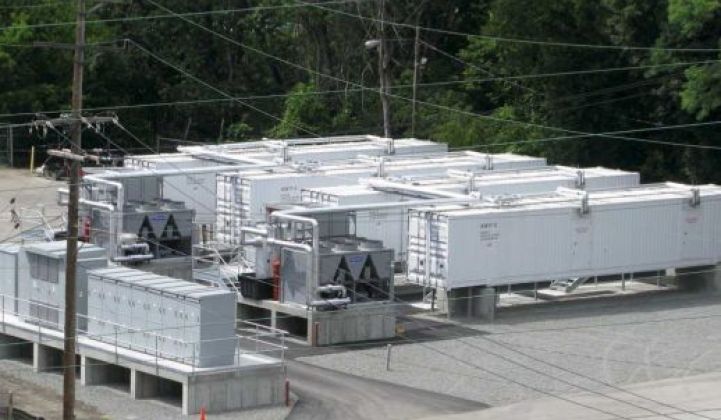Startups and large companies around the world are busy trying to coax something new from the periodic table -- to find a compound or process that will store energy better, faster, and cheaper than the current palette of storage technologies.
We've covered energy storage technology developments extensively at Greentech Media, ranging from batteries to fuel cells to compressed air to flywheels to ice to supercapacitors.
But what if the real innovation in energy storage is not destined to emerge from a "black swan" compound in a lab but from a boardroom with a creative take on how to run an energy storage business?
AES Energy Storage is part of the enormous AES, an energy company that emerged from the deregulated energy environment to become a major player in renewable energy development as well as coal plants, natural gas, and hydroelectric plants. The company is bullish enough on utility-scale energy storage to have devoted a separate division to its activity in 2007.
I spoke with John Zahurancik, the VP, Deployment and Operations, at AES Energy Storage about the storage market, regulatory issues, and the firm's larger projects.
Big news first: AES is bidding on a 400-megawatt battery storage system for a Long Island Power Authority (LIPA) request for new power. This project would be the largest battery-based storage system to-date and is being considered as an alternative to new generation on Long Island. It's a 1,600-megawatt-hour system providing operating reserve services.
“Zahurancik considers these energy services, not power services and sees that movement towards energy services as an important and disruptive shift. He said, "We see them moving into energy services with four hours of duration."
The technology is capable of performing and the price points are where they need to be for certain power services, according to Zahurancik. "It really is a matter of getting the commercial side of the business," he said
Regulatory Challenges
Energy storage coming on the grid will be a gradual process and will start with low-hanging fruit like frequency regulation and eventually shift to other services. But the ISOs are becoming comfortable with energy storage, according to the AES VP. He mentions PJM and NYISO as examples. New ideas like a storage system taking energy off the grid when there is a surplus is starting to be something that the ISOs can now consider.
Because there are protocols around generation with levels and metrics that do not take energy storage into account, there are arbitrary barriers preventing storage from participating in certain markets. But Zahurancik says that these are artificial constructs that limit storage and that can be changed.
Zahurancik said, "If the power plant is really a storage plant, it has three or four other elements of value." The utility "is buying things I want to sell -- they're just not used to seeing it all in one shopping cart." For example, storage could help address the cost of curtailment, RPS, flexibility of deployment, and the timing of new resources. These things are not traditionally bundled.
Today, AES' energy storage on-line is 24 megawatts; by the end of the year, it will be 88 megawatts. About 4 megawatts of that total are pilot programs but 84 megawatts are in service.
These projects, which provide 15 to 20 minutes of storage, include:
- 12 megawatts of spinning reserve in Chile
- 32 megawatts of frequency regulation in the PJM territory
- 20 megawatts in Chile (This project and the other Chile project use lithium ion batteries from A123)
"Once we were comfortable with the technology -- we prospected for challenging problems that didn't have great solutions." Chile is among the many countries in which AES operates; it has an industrial base with a large mining component in its northern grid. The loads come on and off erratically on a fragile grid. That has placed a heavy reserve on the power resources in the region.
Storage has performed better than the power reserve strategy, according to AES.
Energy Storage Technologies
"When we started in this business, it was unheard of to use lithium-ion," said Zahurancik. But that technology has become the go-to material. "Lithium-ion is understood and packaged," according to Zahurancik, "but we track over 100 technology companies at various levels of activity -- with a handful that we think are in the top tier." These include flow batteries, lithium-ion, and advanced lead acid batteries.
Since AES also has a unit that develops wind farms, AES has some synergies in this combination. The firm is developing a 32-megawatt storage facility integrated with a small 100-megawatt wind farm. The sister company, the wind division, will own and operate the entire facility. That synergy is an "advantage of being part of AES."
There's a good movie from a few years back called Power Trip which covers AES' activity in trying to modernize and commercialize the former Soviet state of Georgia's power grid. In my capacity as Greentech Media's movie and cultural critic, I highly recommend it. In Zahurancik's words, "It illustrates some of the culture of the company -- committed people trying to make the power system in Georgia work. Sometimes it feels a lot like that in the storage market -- [there are] a lot of legacy elements to the way people think about things."



